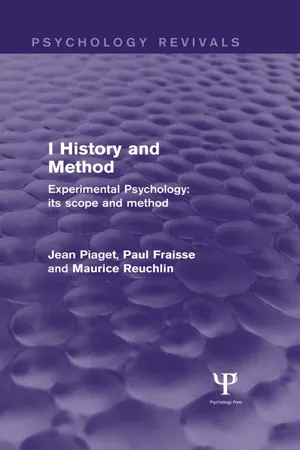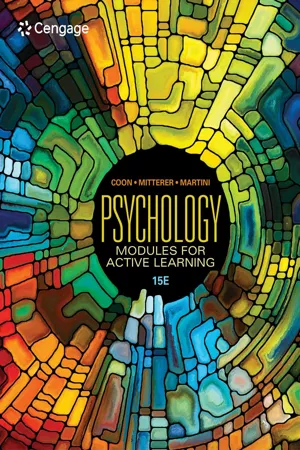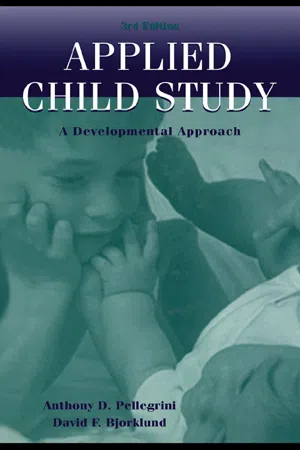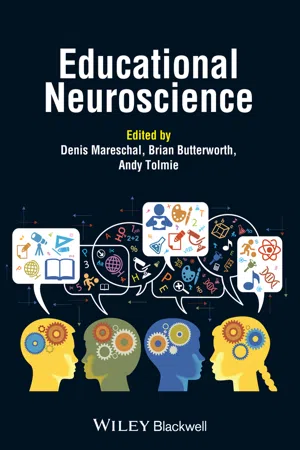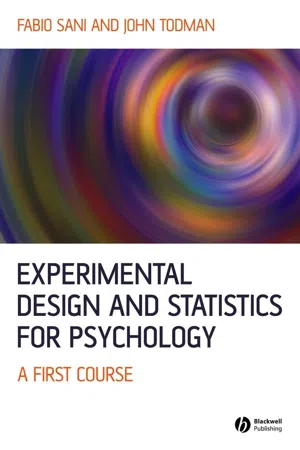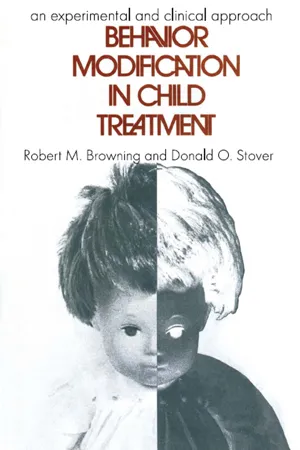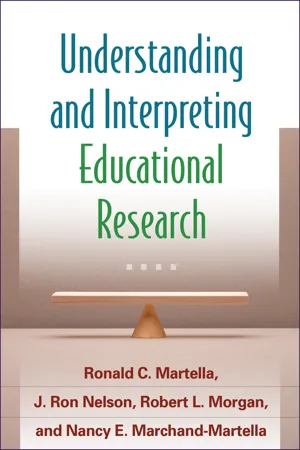Psychology
Experimental Method
The experimental method in psychology involves conducting controlled experiments to investigate cause-and-effect relationships between variables. It typically includes manipulating an independent variable and measuring its effects on a dependent variable. This method allows researchers to establish causal relationships and make inferences about the impact of specific factors on behavior or mental processes.
Written by Perlego with AI-assistance
Related key terms
1 of 5
12 Key excerpts on "Experimental Method"
- eBook - PDF
Research Methods
A Tool for Life
- Bernard C. Beins(Author)
- 2017(Publication Date)
- Cambridge University Press(Publisher)
Complications arise in any research project because small details of the research situation often have effects on participants’ behaviors that we don’t anticipate or even recog- nize. Further, because an experimental session involves an interaction between people—an experimenter and a participant—social effects can contribute to changes in behavior. Nonetheless, we try to construct our research design to have maximal reliability and internal validity. We create an experimental approach that others can repeat and obtain the same pattern of results; we also put together a study whose results provide meaningful answers to our questions. CHOOSING A METHODOLOGY: THE PRACTICALITIES OF RESEARCH In psychology, the word experiment has a specific meaning. It refers to a research design in which the investigator actively manipulates and controls variables. Scientists regard Experimental Methods of research as the gold standard against which we compare other approaches because experiments let us determine what causes behavior, which can lead to the ultimate scien- tific goal—control. In general, researchers often prefer experiments over other methods such as surveys, observational studies, or other descriptive and correlational approaches. Experiment—A research project in which the investigator creates initially equivalent groups, systematically manipulates an inde- pendent variable, and compares the groups to see if the independent variable affected the subsequent behavior. 150 CHAPTER SIX It is important to understand the difference between an experiment and other ways of carrying out a research project because in everyday language people often refer to any data collection project as an experiment. In fact, until the middle of the 1900s, psycholo- gists, like other scientists, referred to any research project as an experiment. Since then, however, psychologists have used the term in a specific way. - eBook - ePub
Experimental Psychology Its Scope and Method: Volume I
History and Method
- Jean Piaget, Paul Fraisse, Maurice Reuchlin(Authors)
- 2014(Publication Date)
- Psychology Press(Publisher)
Chapter 2 The Experimental Method Paul Fraisse 1 The nature of the Experimental MethodExperimental psychology represents that body of knowledge acquired in psychology by the use of the Experimental Method. After a century of productiveness in the physical, natural and human sciences, this method no longer needs introduction. Moreover, it would be difficult to add anything to the work of Claude Bernard except that in each science the Experimental Method has its own procedures and rules, which are the outcome of difficulties encountered and overcome by past workers. We propose to try and explain the specific problems of the experimental approach in psychology.Whatever the actual subject matter of each experimental procedure may be the method remains the same in principle. Although the experimenter’s first move must be guided by the fact, he will not be satisfied with that. His aim is to discover new facts,1 and he cannot do this unless he knows all the conditions governing their appearance. At that particular moment he is capable of foresight. But to achieve this end, the experimenter had had to connect together the intricate relationships between the essential facts, and the more complex his object the longer and more difficult the task will have been.It is a matter of disentangling a thread and of proceeding by stages in order to succeed. Each stage is characterized by the establishment of a relation between two or more facts . The graduated network of these relations constitutes the body of a science.The Experimental Method is really only a way of acquiring knowledge. Its essential feature is to maintain the coherence of a system of relations controlled by the experiment. This mode of knowledge is essentially distinct from that of philosophy, which is based on the evidence of propositions and the demands of reflexive thought, and culminates in a system of knowledge as coherent as possible. Its reasoning is directed by the laws of thought, while in science, this control is ensured by empirical verification. It is nevertheless true that the experimenter’s task does not consist merely of recording facts or even relations. Scientific activity is also the work of thought and, as Claude Bernard showed, we must be concerned less with method than with experimental reasoning. The fact is invoked or elicited essentially to verify the hypothesis set up by the experimenter. ‘A fact is nothing by itself, it has value only through the idea to which it is attached or through the proof it furnishes’. (Claude Bernard, p. 93.) But what is a fact in psychology? Even the history of psychology is in a sense the history of answers to this question (see Chapter 1 - eBook - PDF
Psychology
Modules for Active Learning
- Dennis Coon, John Mitterer, Tanya Martini, , Dennis Coon, John Mitterer, Tanya Martini, (Authors)
- 2021(Publication Date)
- Cengage Learning EMEA(Publisher)
The Experimental Method allows the careful control of con-ditions to bring cause-and-effect relationships into sharp focus (Stangor, 2015). Hence, it is generally accepted as the Experiment A study in which the investigator manipulates at least one variable while measuring at least one other variable. Like Chan, we all conduct little experiments to detect cause-and-effect connections. In a more formal way, that is exactly what psychologists do when they want to understand why we act the way we do. Let’s see why. Copyright 2022 Cengage Learning. All Rights Reserved. May not be copied, scanned, or duplicated, in whole or in part. Due to electronic rights, some third party content may be suppressed from the eBook and/or eChapter(s). Editorial review has deemed that any suppressed content does not materially affect the overall learning experience. Cengage Learning reserves the right to remove additional content at any time if subsequent rights restrictions require it. PSYCHOLOGY MODULES FOR ACTIVE LEARNING 38 most powerful scientific research tool. To perform an ex-periment, you would do the following: 1. Directly vary a condition that you think might affect behavior. 2. Create two or more groups of participants. These groups should be alike in all ways except the condition you are varying. Usually, one group serves as a control group with which the other groups are compared. 3. Record whether varying the condition has any effect on behavior. Suppose that Chan just happened to be a psychologist who wanted to find out if using smart glasses while driving af-fects the likelihood of having an accident. First, he would form two groups of people. Then he could give the members of one group a test of driving ability while using their smart glasses. The second group would take the same test without using smart glasses. By comparing the average driving abil-ity scores for the two groups, he could tell if the use of smart glasses affects driving ability. - eBook - PDF
- Siri Carpenter, Karen Huffman(Authors)
- 2012(Publication Date)
- Wiley(Publisher)
Then compare your responses with those in Appendix B. experimental research A carefully controlled scientific procedure that determines whether variables manipulated by the experimenter have a causal effect on other variables. Note that the four methods are not mutually exclusive. Researchers may use two or more methods to explore the same topic. THE PLANNER ✓ ✓ Study Organizer 1.2 Psychology’s four major research methods Method Purpose Advantages Disadvantages Experimental (manipulation and control of variables) Identify cause and effect (meets psychology’s goal of explanation ) Allows researchers to have precise control over variables, helps identify cause and effect Ethical concerns, practical limitations, artificiality of lab conditions, uncontrolled variables may confound results, researcher and participant biases Descriptive (naturalistic observation, surveys, case studies) Observe, collect, and record data (meets psychology’s goal of description ) Minimizes artificiality, makes data collection easier, allows description of behavior and mental processes as they occur Little or no control over variables, researcher or participant biases, cannot identify cause and effect Correlational (statistical analyses of relationships between variables) Identify relationships and assess how well one variable predicts another (meets psychology’s goal of prediction ) Helps clarify relationships between variables that cannot be examined by other methods and allows prediction Little or no control over variables, cannot identify cause and effect Biological (studies the brain and other parts of the nervous system) Identify contributing biological factors (meets one or more of psychology’s goals) Shares many or all of the advantages of experimental, descriptive, and correlational research Shares many or all of the dis-advantages of experimental, descriptive, and correlational research 0 3 2 1 3 2 1 - eBook - PDF
Research in Psychology
Methods and Design
- Kerri A. Goodwin, C. James Goodwin(Authors)
- 2016(Publication Date)
- Wiley(Publisher)
This method . . . has no ‘independent variable’ but treats all the measured variables alike” (p. 3). You will learn more about correlational research in later chapters. In this and the next three chapters, however, the focus will be on the Experimental Method, the researcher’s most powerful tool for identifying cause‐and‐effect relationships. After all, as psychologists we seek to discover the causes of behavior; thus, the Experimental Method is the best tool to help up understand those causes and what effects they have on behavior. Essential Features of Experimental Research Since Woodworth’s time, psychologists have thought of an experiment as a systematic research study in which the investigator directly varies some factor (or factors), holds all other factors constant, and observes the results of the variation. The factors under the control of the Essential Features of Experimental Research 131 experimenter are called independent variables, the factors being held constant are the extraneous variables, and the behaviors measured are called dependent variables. Before we examine these concepts more closely, however, you should read Box 5.1, which describes the logical founda- tions of the Experimental Method in a set of rules proposed by the British philosopher John Stuart Mill in 1843. BOX 5.1 ORIGINS—John Stuart Mill and the Rules of Inductive Logic John Stuart Mill (1805–1873) was England’s preeminent 19th century philosopher. Although he was known primarily as a political philosopher, much of his work has direct relevance for psychology. For example, his book on The Subjection of Women (1869) argued forcefully and well ahead of its time that women had abilities equal to those of men and ought to be treated equally with men. - eBook - ePub
Applied Child Study
A Developmental Approach
- Anthony D. Pellegrini, David F. Bjorklund(Authors)
- 1998(Publication Date)
- Psychology Press(Publisher)
Despite this commonsense approach, there seems to be a “paradigm war” (Gage, 1989) raging between experimentalists and interpretive, naturalistic researchers, especially in the area of educational research. Although polemics are helpful at the beginning of major disagreements between groups so that they can each define themselves clearly, at this point we should recognize that there is no one “silver bullet” or crystal ball that will provide all the answers. We should draw what we can from each approach to help us better understand the complexities of childhood.SOME BASIC PREMISES OF Experimental MethodS
Whereas naturalistic approaches attempt to study children in the everyday environment, the experimental approach attempts to create an experimental, often contrived, environment in which to examine children. Aspects of the environment thought to affect children’s behavior are manipulated and controlled. Through manipulation and control researchers can make causal inferences about these manipulations.Experimental environments can be real classrooms, as in the cases of field experiments of curriculum and design (P.K.Smith & Connolly, 1980), laboratories, where children are taken from their natural habitats and studied (Pellegrini & Perlmutter, 1989), or hybrid designs where parts of classrooms are experimentally controlled and manipulated (I.Jones & A.D.Pellegrini, 1996). These terms manipulate and control are crucial to the Experimental Method, and are discussed in greater depth later because they help us make causal inferences about sets of variables.Generally, experiments are conducted in order to isolate specific cause-effect relationships. That is, experimenters attempt to identify the effects of certain independent variables (e.g., crowding) on behavior, or dependent variables (e.g., children’s aggression). The independent variables are manipulated to examine their effect on the dependent measure. Other, extraneous, variables are controlled so that they do not influence the relation between independent and dependent variables, and thus cloud the causal picture. Experiments that give us insight into the effects of an independent variable on a dependent variable, without confounding effects of extraneous variables, are said to be internally valid.Experiments are thus most beneficial where the investigator is interested in identifying such cause-effect relationships. Further, experiments can be conducted only in situations where investigators are free to manipulate and control aspects of the children’s environment. For example, to investigate the cause-effect relationhip between certain styles of teachers’ reading books to children and children’s literacy, the investigator must be free to vary, or manipulate, different reading environments. - eBook - PDF
- Denis Mareschal, Brian Butterworth, Andy Tolmie, Denis Mareschal, Brian Butterworth, Andy Tolmie(Authors)
- 2013(Publication Date)
- Wiley-Blackwell(Publisher)
By exam- ining performance across these groupings, it becomes possible to determine which characteristics reflect chronological age, which reflect mental age, and which are specific to autism. Research Methods in Educational Psychology 123 Experimental designs Experimental designs are specifically intended to identify cause-and-effect relationships in unequivocal fashion, through the use of random assignment of participants to experimental conditions (i.e., levels of the independent variable hypothesized to have a causal influence on the dependent variable). However, isolating causal influences depends on more than random assign- ment: it is also necessary to ensure that the independent variable is not con- founded with other variables that systematically covary with it. Confounding variables are a major hazard for experimental research in educational psy- chology, since tight control of conditions of the kind common in laboratory research is often impossible. It is important therefore to take specific precau- tions to guard against their intrusion. For this reason, experimental research typically focuses on simple compe- tence measures or brief observations, collected in out-of-class settings where some degree of standardization is possible. Where more than one element of data is being collected (for instance, performance on several tasks), it is standard practice to counterbalance these (e.g., with two tasks, half of the participants engage with these in the order A then B, and the other half B then A), or else, with larger numbers of points of data collection, to randomly vary the sequence. This ensures that task order can exert no systematic effect on outcome. There are various other known sources of confounding variables that particularly affect research employing measurement at multiple time points, such as intervention trials, and the possible impact of these should be considered as a matter of course when implementing designs of this kind. - eBook - PDF
The Practical Researcher
A Student Guide to Conducting Psychological Research
- Dana S. Dunn(Author)
- 2012(Publication Date)
- Wiley-Blackwell(Publisher)
164 CHAPTER OUTLINE Formulating a Testable Hypothesis Developing an Experimental Hypothesis Operational Versus Descriptive Definitions Reliability and Validity Reliability of a Measure Construct Validity Validity and Psychological Testing Closing Comments on Reliability and Validity Manipulating Independent Variables Control Groups Are Essential Special Cases: Subject Variables Error Measuring Dependent Variables Avoiding Bias Pilot Testing Demand Characteristics Experimenter Bias Sampling and Assigning Participants Sampling Issues Simple Assignment Techniques Research Design: Factor and Factorial One-Factor Designs: Posttest-Only and Pretest–Posttest 2 × 2 Designs and Beyond Other Design Options: Subject Variables Revisited Within-Subjects Designs Between and Within Factors Combined: Mixed Designs Single-Participant Experiments Conclusion: A Model of the True Experiment Experimental Research 6 165 Chapter 6: Experimental Research In many ways, the first half of this book was preparation for this chapter, in which the experimental approach to psychological research is reviewed in detail. The advantage of the experiment is clear: It allows the practical researcher to tease cause apart from effect and to effectively rule out competing explanations in favor of a sole account of some phenomenon. To get to that point, of course, the theoretical and practical sides of experimental research must be reviewed in detail, including the role of hypothesis testing, the manipulation of indepen- dent variables, the measurement of dependent variables, and the selection of an appropriate research design. A variety of exercises and suggestions accompany each of these topics, and such details add to the precision of your experiment and enhance its likelihood of success. - eBook - PDF
Experimental Design and Statistics for Psychology
A First Course
- Fabio Sani, John Todman(Authors)
- 2008(Publication Date)
- Wiley-Blackwell(Publisher)
THE NATURE OF PSYCHOLOGY EXPERIMENTS (I): VARIABLES AND CONDITIONS 17 SUMMARY OF CHAPTER • In an experiment, the things that are supposed to stand in a causal rela-tionship are called ‘variables’, as the levels of these things are free to vary. • There exist two types of variable. A variable whose levels are predetermined (manipulated) by the researcher is called an ‘independent variable’ (IV). A variable whose levels depend on, or are affected by, variations in the IV is called a ‘dependent variable’ (DV). • Manipulating the IV implies assigning participants to two ‘conditions’ of the experiment, which differ in terms of the level of the IV to which par-ticipants are exposed. In the ‘experimental condition’ the researcher delib-erately alters the normal level of the IV, while in the ‘control condition’ no attempt is made to make any alteration. • Assessing variations in the levels of the DV requires devising a plausible indicator of the thing represented by the DV, and a precise way to measure the DV. • Most variables may be used either as IVs or as DVs, depending on the nature of the experiment. However, some variables, such as age, sex and ethni-city, cannot be used as DVs in experiments, because their levels cannot be affected by variations in the IV. CHAPTER THREE The Nature of Psychology Experiments (II): Validity In the previous chapter we discussed some core concepts in experimental psychology with the aid of an example of an experiment. In this fictitious experiment, we pro-pose to test the hypothesis that people who are in a good mood perform better on intellectual tasks than people who are in a neutral mood. To test this hypothesis, we create two conditions (with participants randomly assigned to these conditions), one in which a group of participants watch a movie excerpt with a funny content (the experimental condition) and one in which another group of participants watch an excerpt with an emotionally neutral content (the control condition). - eBook - ePub
Behavior Modification in Child Treatment
An Experimental and Clinical Approach
- Robert M. Browning(Author)
- 2017(Publication Date)
- Routledge(Publisher)
CHAPTER ONE The Experimental-Clinical MethodThe scientific method must be the basis for treatment of psychologically disturbed persons. The clinician should identify and measure behavioral problems in the same manner that the physical scientist approaches any natural phenomena. As an applied scientist, the clinician should combine basic psychological knowledge with current observations of his patient to form testable treatment hypotheses. Factual understanding of the patient’s behavior derived from experimental tests of these hypotheses should then be the basis for the design and execution of a total treatment program. Finally, the clinician should be capable of objectively evaluating his treatment procedures and, consequently, his understanding of the patient. This technological ideal is the experimental-clinical method.Experimental Methods are seldom employed in current clinical practice. Most clinicians have difficulty accepting science as even one of the boundaries of practice, and would vehemently reject the proposition that scientific methodology should stand as a central pillar of treatment. Instead, they state that the complexities of human feeling and action cannot be measured and that the treatment of unique individual behavior is the proper province of art.Traditionally, there has been a marked difference between the scientific and the clinical approaches to the problem of psychological disturbance. Arising from philosophical questions about the nature of man, and motivated by a search for knowledge, the scientific orientation has become formalized in the pure research of academic psychology. In contrast, the clinical approach has its roots in the humanistic tradition and is motivated by the desire to alleviate human suffering by treating disturbances of individual functioning.As clinical psychologists, the authors have been acutely aware of the continuing antithesis of scientific and clinical approaches to human behavior. Our training included a heavy emphasis upon academic psychology, Experimental Method, statistical design, and the other accoutrements of pure behavioral research. However, we were also deeply immersed in clinical problems and traditional treatment methods. In our training, as in our current view of the field, we could seldom find useful relationships between the experimental approach of the university and the practice of the clinic. As clinicians, we have been deeply concerned about the complexities of individual human behavior and we have shared with our clinical colleagues the conviction that the uniqueness of an individual personality can never be comprehended within the rigid rules of the currently revered behavioral science methodologies. As scientists, however, we have valued a degree of preciseness, experimental control, and predictiveness that the vagaries and ambiguities of the usual clinical methods are unable to provide. The great masses of scientific data contained in archival journals relate only peripherally to the human problems that arise daily in a clinic. There is a plethora of studies on basic learning processes, unconscious motivation, perception, and the physiological correlates of behavior, but the gap between these experimental studies and the patients in our offices is great. Integrity prohibits their direct application with anything less than intense skepticism. We regret the absence of a meaningful technological literature and are unwilling to accept in its place the lore of traditional clinical practice which, be it analytic, phenomenological, or behavioral, is replete with subjective evaluation, dogmatic belief, and mystical thinking. Thus, we have found ourselves in conflict between the apparently antithetical values of behavioral science and clinical practice. - Ronald C. Martella, J. Ron Nelson, Robert L. Morgan, Nancy E. Marchand-Martella(Authors)
- 2013(Publication Date)
- The Guilford Press(Publisher)
The goal of many experimental researchers is to find general laws that hold true for large numbers of people. Thus, the attempt is to gather a sample of partici- pants for an investigation that is representative of the entire population or some target popula- tion. (Note. Sampling methods are discussed in Chapter 4.) Experimental Methods A major feature of much experimental or group research is the attempt to find cause-and-effect Causal– Comparative Naturalistic/ Descriptive Case Study Correlational Experimental Experimental/ Group Single Case Quantitative Qualitative Quantitative– Qualitative Mix Chapter 6 Chapter 7 Chapters 9 and 10 Chapters 4 and 5 (group) and 11–13 (single case) High Constraint Low Constraint FIGURE 1.6. Continuum of constraint levels for different research methods. Note. The categories of quanti‑ tative and qualitative methods are for general guidance only, since case study and naturalistic and descrip‑ tive research methods can also fall under the category of quantitative research, depending on how the data are collected and analyzed. Survey research (Chapter 8), program evaluations (Chapter 14), and action research (Chapter 16) can also have aspects of both quantitative and qualitative research methods. 1. Thinking Critically about Research 23 relationships. In order to do this, researchers manipulate the independent variable. Recall that an independent variable may have an effect on the dependent variable. For example, a computer tutorial used in your class can be considered an independent variable, and the knowledge the students gain is the dependent variable. An experimental researcher may provide the com- puter tutorial to your class and not to another, and make comparisons on a test at the end of some specified period of time. Thus, the assump- tion is that the researcher can determine whether the independent variable (i.e., computer tutorial) caused changes in the dependent variable (i.e., knowledge gained).- No longer available |Learn more
- Frederick J Gravetter; Lori-Ann B. Forzano; Tim Rakow, Frederick Gravetter, Frederick Gravetter, Lori-Ann Forzano, Tim Rakow(Authors)
- 2021(Publication Date)
- Cengage Learning EMEA(Publisher)
C H A P T E R 7 \ The Experimental Research Strategy 169 As shown in Figure 7.3, it is possible that a third variable is responsible for the apparent relationship. The possibility of any direct causal connection between variables can be tested using manipulation. In this example, we could manipulate ice-cream consumption (hand out free ice cream) and monitor crime rates. Presumably, increasing ice-cream consumption would have no influence on crime rates. Similarly, we could manipulate crime rates (start a massive police initiative) and monitor ice-cream consumption. Again, it is unlikely that changing the crime rate would have any effect on ice-cream consumption. In an experiment, the researcher is responsible for causing the independent variable to change by direct manipulation. In this way, the researcher can be confident that changes in the independent variable are not being caused by some outside variable (a third variable) that could influence the outcome of the study. Thus, the act of manipulation helps eliminate one aspect of the third-variable problem in an experiment. Control The second distinguishing characteristic of an experiment is control of other variables; specifically, variables other than the independent and dependent variables. To accurately evaluate the relationship between two specific variables, a researcher must ensure that the observed relationship is not contami- nated by the influence of other variables. Control and the third-variable problem In general, the purpose of an experiment is to show that the manipulated variable is responsible for causing the changes observed in the dependent variable. To accomplish this, an experiment must rule out any other possible explanation for the observed changes; that is, eliminate all confounding variables. In Chapter 6 (‘Confounding variables’) we defined a confounding variable as a third-variable that is allowed to change systematically along with the two variables being studied.
Index pages curate the most relevant extracts from our library of academic textbooks. They’ve been created using an in-house natural language model (NLM), each adding context and meaning to key research topics.

